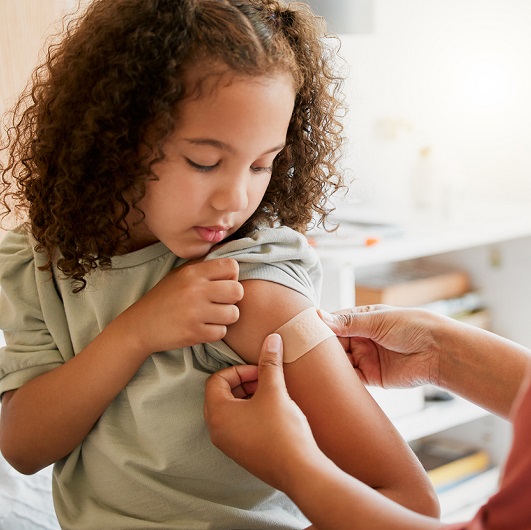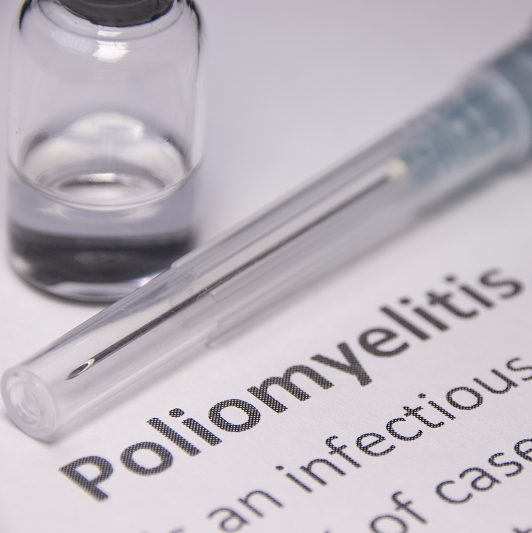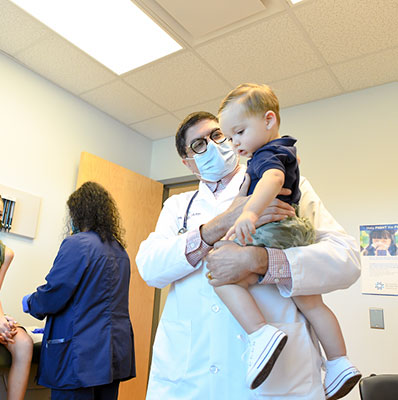Understanding Childhood Vaccines: Safety and Side Effects

July 09, 2025
Understanding childhood vaccines can feel overwhelming. To make matters worse, there’s a lot of confusing and incorrect information out there, making it hard to know what’s true.
We invited Daniel Ruderfer, M.D.,chief of the Division of Pediatric Infectious Diseases at K. Hovnanian Children’s Hospital, and Moses F. Olorunnisola, M.D., a pediatrician with Hackensack Meridian Medical Group in Forked River, to explain what vaccines are, how they work and the most common side effects.
What Are Vaccines and How Do They Work?
Vaccines help protect kids from dangerous diseases. They work by giving your child’s body a tiny bit of a germ, like a virus or bacteria. This small amount won't make your child sick, but it teaches their body how to fight it off.
Think of it like this:
- Immune system: your body’s army
- Vaccine: the training exercise
- Antibodies: special guards
The vaccine is training your immune system (army) to fight. This process will create special guards called antibodies. An antibody is a protein that watches for an infection and, if one is spotted, sounds the alarm for your immune army to go after it.
"With a vaccine," says Dr. Ruderfer, "we can expose a person to a small amount of a specific infection to stimulate their immune system, so if they later encounter that infection 'in the wild,' their body has a good chance of overcoming it or having a less severe case.”
These antibodies can stick around for years, sometimes even a lifetime! This protection is especially important for babies and young children because their immune systems are still developing.
What’s in a Vaccine?
Parents often have questions about what's actually in vaccines.
Every vaccine ingredient has a purpose. As Dr. Ruderfer explains, "Every ingredient serves a purpose — it’s intentionally there.”
Here's a simple breakdown of some commonly used ingredients:
Antigens: The main ingredient
The antigen is like a “wanted poster” for your immune system. It’s a tiny piece of a germ (like a virus or bacteria) that teaches your body how to fight off the real thing. It’s not enough to make you sick, but it’s enough to train your immune army.
Antigens are made in different ways:
- Weakened: The germ is alive, but very weak
- Killed: The germ is dead
- Subunit: Just a small piece of the germ
- Toxoid: The germ’s toxin (poison) is neutralized
- mRNA: Instructions for your body to make a piece of the germ
Adjuvants: Boosting the signal
Adjuvants help vaccines work better. They make the immune system react more strongly to the antigen, so you get better protection, adds Dr. Olorunnisola.
A common adjuvant is aluminum salts. These are safe and have been used in vaccines for adults and children since the 1930s.
You can also find aluminum in things like baby formula, vegetables and soil. The amount in vaccines is tiny – “In a vaccine, when aluminum is in there, it’s a tiny fraction of what you’d see in a can of tuna,” says Dr. Ruderfer. “It’s in the vaccine for a reason — it amplifies the immune system benefit.”
“An adjuvant makes a good vaccine into an excellent vaccine,” says Dr. Ruderfer.
Stabilizers: Keeping vaccines fresh
Stabilizers help keep the vaccine's active ingredients working properly. They protect the vaccine from things like light and temperature changes. Common stabilizers are sugars, like sucrose and lactose (the same sugars in many foods).
These ingredients ensure the vaccines stay safe and effective, and are safe for both adults and babies.
Preservatives: Preventing contamination
Some vaccines come in multi-dose vials, meaning one bottle that holds many doses. Even though doctors use a new needle every time, there’s a small chance that germs could get into the vial.
Imagine it like a big jug of juice that everyone at a party is drinking from. Even if everyone uses a clean straw, there’s still a chance germs could get into the juice.
Preservatives are like adding something to the juice to keep it from spoiling. They prevent bacteria and fungi from growing in the vaccine bottle, keeping it safe for everyone.
Many vaccines now come in single-serving containers (like single juice boxes) so they don’t need preservatives. However, some vaccines, like the polio vaccine, still come in multi-dose vials and need preservatives to keep them safe. A small amount of an organic compound called 2-phenoxyethanol is added to do the job and keep the vaccine safe.
Residuals: Tiny leftovers
Residuals are tiny traces of substances used during the manufacturing process. These are present in extremely small amounts and are not harmful. Examples include:
- Antibiotics (like neomycin): Used during manufacturing.
- Formaldehyde: Used to inactivate viruses.
Think of it like launching a spaceship: The antibiotics and formaldehyde are like the booster rocket that launches the astronauts' capsule into space. After the launch, the booster falls away. These ingredients help with the takeoff and creation of a safe vaccination, but are then quickly processed out of the system.
How Are Vaccines Tested?
Childhood vaccines go through a lot of testing before they’re ever given to kids.
“Testing for all routine vaccines used in the U.S. follow a standardized process from the FDA [Food and Drug Administration],” says Dr. Ruderfer.
Here’s how vaccine testing works:
1. Lab testing: Scientists first test the vaccine in a lab and on animals.
2. Human testing (3 phases):
- Phase 1: A small group of volunteers (up to 100) receive the vaccine.
- Phase 2: A larger group of people (hundreds) receive the vaccine.
- Phase 3: Thousands of people receive the vaccine.>
3. Testing in adults first: Vaccines for kids are usually tested in adults first, then children and finally infants.
4. Ongoing monitoring: Even after a vaccine is approved, scientists continue to watch for any rare or long-term side effects.
Vaccines that receive Emergency Use Authorization, such as the COVID-19 vaccine, still undergo rigorous testing in the years that follow.
The polio vaccine: A case study
The polio vaccine is a good example of how ongoing monitoring works.
- The old polio vaccine: The U.S. used to use an oral polio vaccine (taken by mouth) made with a weakened virus. It worked well for many years.
- A rare problem: Scientists discovered that in very rare cases (about 1 in 2.7 million doses), the weakened virus could change and cause paralysis with the oral polio vaccine.
- A safer solution: Because of this discovery, the U.S. switched to a vaccination with an inactivated (killed) polio virus. This vaccine is much safer.
"This rigorous testing and review process is why we can come out boldly for our childhood vaccines in the U.S. and say, ‘Yes, they’re safe,’" says Dr. Olorunnisola.
This careful testing and monitoring helps ensure that childhood vaccines are as safe as possible.
What Are the Most Common Side Effects of Childhood Vaccines?
It's normal to wonder about side effects. While it's always a good idea to talk to your doctor about any concerns, especially if your child has allergies or other health conditions, serious side effects from vaccines are very rare.
"Risk for side effects with childhood vaccines is minimal," says Dr. Ruderfer. "I’ve never seen any of the severe reactions — they do exist, but it’s extremely rare.”
Common side effects
Most kids experience only mild side effects, such as:
- Soreness: The area where the shot was given might be sore.
- Redness or hardness: The injection site might be red or feel hard. This is a normal reaction and doesn't mean there's an infection.
- Fever: Some kids get a low-grade fever.
"I actually like hearing when that happens, because it means the immune system is responding and that army training is starting," says Dr. Ruderfer.
These side effects are usually mild and go away within a day or two.
If you have any questions or concerns about vaccine side effects, talk to your doctor. They can help you understand what's normal and what's not.
Next Steps & Resources:
- Meet our sources: Daniel Ruderfer, M.D., and Moses F. Olorunnisola, M.D.
- To make an appointment and discuss vaccines with a pediatrician near you, call 800-822-8905 or visit our website.
- Learn more about Hackensack Meridian Children’s Health.
- Explore more about parent vaccine decision making.
- Watch our podcast on Navigating the Noise on Pediatric Vaccines.
The material provided through HealthU is intended to be used as general information only and should not replace the advice of your physician. Always consult your physician for individual care.








